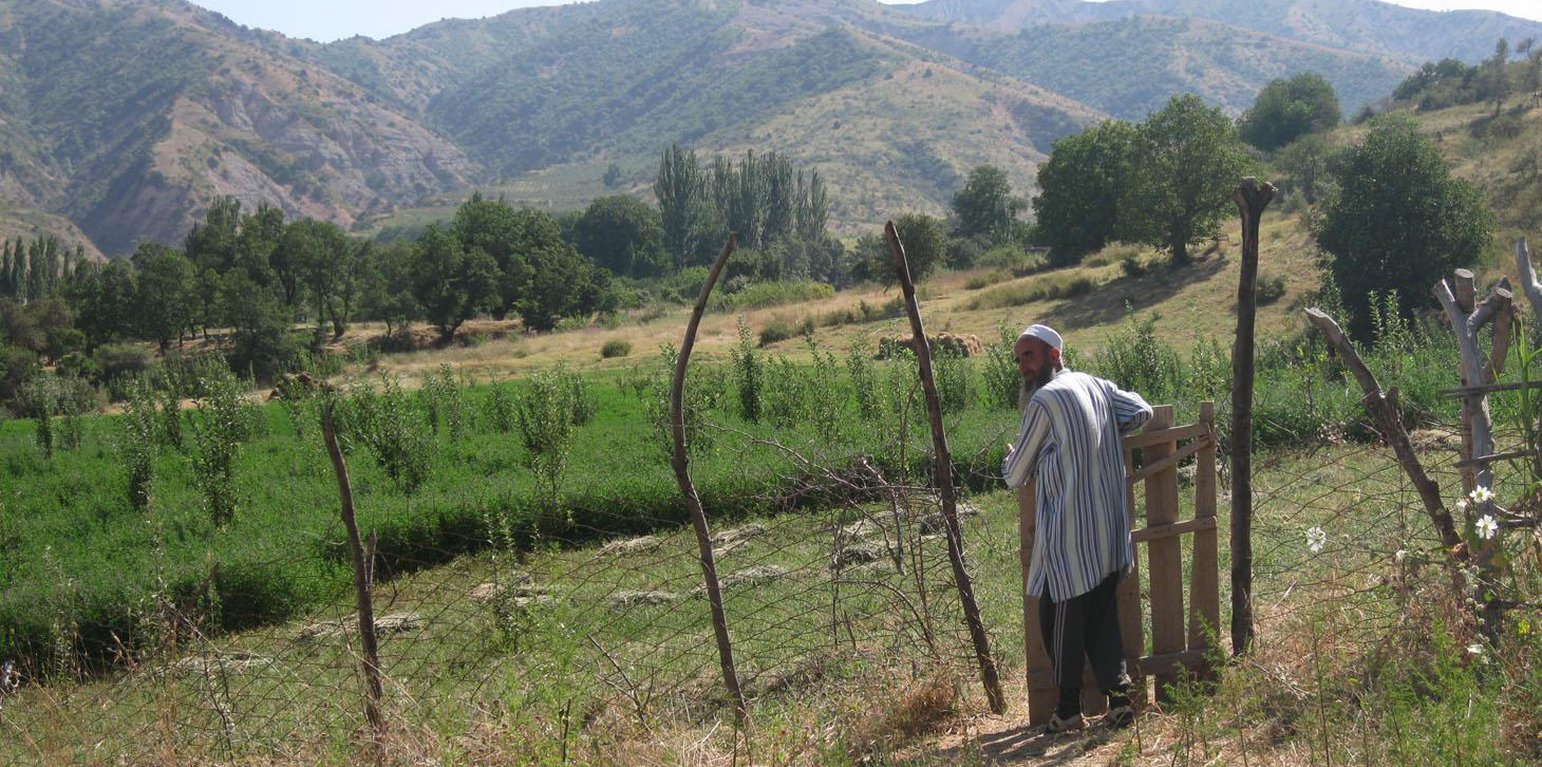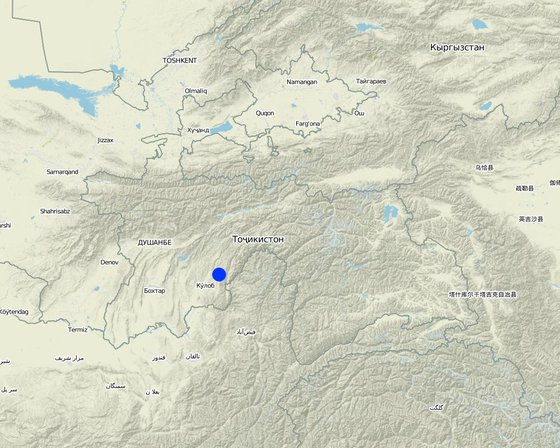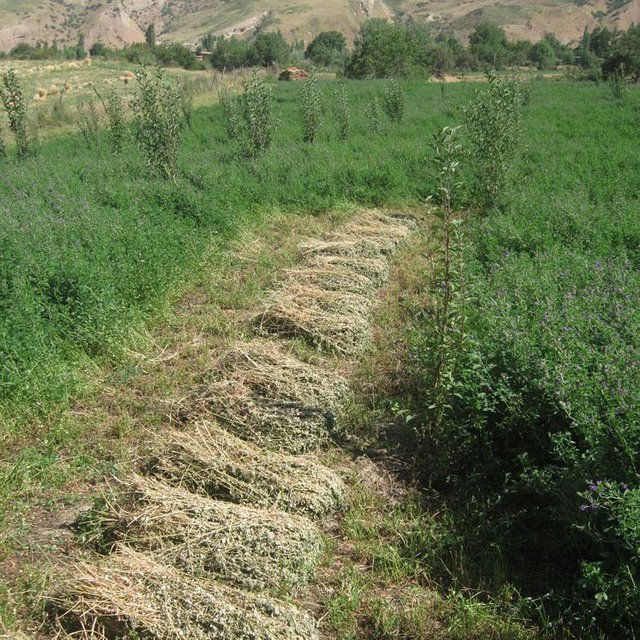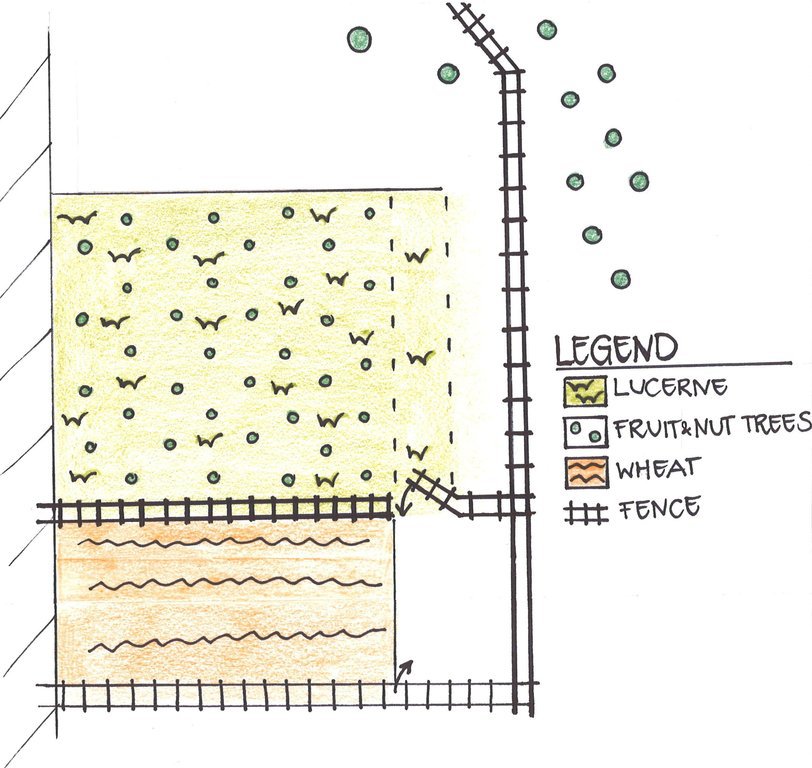



In 2009 the farmer changed his wheat plot into an Alfalfa plot where he also planted fruit tree seedlings in between to establish an orchard. One hectare is used for the perennial cropping of Alfalfa. Alfalfa cropping supplements beneficial soil functions which are crucial for the establishment of an orchard. The plot lies on a narrow plateau next to other wheat crops. The plot is mainly bordered by fruit and nut orchards on a gentle slope, and by a steep slope of the riverbed. A solid fence prevents boars from entering the area through the nut orchard. The plot is not accessible by the steep slope. Two fences are built from the side of the neighboring wheat plots. One fence works like an entrance gate to all the plots on that plateau. A second fence indicates the boundaries between the farmers' Alfalfa crop and the wheat plots belonging to other farmers. The whole family is working on the farm land, consisting of several plots which are distributed over the valley. The children are mainly guarding the cropland.
Purpose of the Technology: In order to establish an orchard, first the farmer planted Alfalfa, which maintains more moisture in the soil and hence creates favorable conditions for tree growth. The wheat cropping was drying out the soil. Therefore during heavy rainfall events water infiltration was limited, and the strong runoff washed away the wheat crop. It was the farmer’s initiative to change the crop management, but Caritas Switzerland supported him with a financial grant. Alfalfa can be harvested several times a year, which he can use as fodder for the livestock or as cash crop.
Establishment / maintenance activities and inputs: The first year after the crop rotation there was no benefit, as the Alfalfa did not give any harvest yet. According to the farmer, Alfalfa seeds were relatively cheap (15 TJS per kg) and result in a good harvest. Currently he is harvesting Alfalfa three times a year, wheat could only be harvested once a year. The whole family was involved in the establishment of the alfalfa crop and tree planting, by ploughing, sawing Alfalfa, planting the seedlings and constructing the fence. Despite the fence, the crop is often guarded by the farmer or his children because boars enter his property. After the first year some seedlings dried out which he had to replace. Presently, little maintenance is required, only guarding and cutting Alfalfa.
Natural / human environment: The farmer’s plot is situated on a plateau on the other side of the riverbed, from where the village of Momandion is located. It takes some 15 minutes to get from their house to the plot. One of his neighbors adopted the technology of sowing Alfalfa and planting fruit tree seedlings.

Location: Muminabad, Khatlon, Tajikistan, Tajikistan
No. of Technology sites analysed:
Spread of the Technology: evenly spread over an area (approx. < 0.1 km2 (10 ha))
In a permanently protected area?:
Date of implementation: less than 10 years ago (recently)
Type of introduction









| Specify input | Unit | Quantity | Costs per Unit (USD) | Total costs per input (USD) | % of costs borne by land users |
| Labour | |||||
| Planting trees | Persons/day | 12.5 | 12.4 | 155.0 | 37.0 |
| Planting trees for replacment | Persons/day | 2.1 | 12.4 | 26.04 | 100.0 |
| Plowing labour | Persons/day | 1.0 | 12.4 | 12.4 | |
| Sowing | Persons/day | 0.27 | 12.4 | 3.35 | |
| Equipment | |||||
| Plowing machine | days | 1.0 | 103.5 | 103.5 | 37.0 |
| Petrol | litres | 120.0 | 1.1383333 | 136.6 | 37.0 |
| Plant material | |||||
| Buying trees | trees | 600.0 | 0.62116666 | 372.7 | 37.0 |
| Buying tree replacments | trees | 100.0 | 1.035 | 103.5 | 100.0 |
| Seeds | kg | 20.0 | 3.1 | 62.0 | 37.0 |
| Construction material | |||||
| Fence | area | 1.0 | 1490.7 | 1490.7 | 37.0 |
| Total costs for establishment of the Technology | 2'465.79 | ||||
| Total costs for establishment of the Technology in USD | 2'465.79 | ||||
| Specify input | Unit | Quantity | Costs per Unit (USD) | Total costs per input (USD) | % of costs borne by land users |
| Labour | |||||
| Soil loosening | Persons/day | 9.375 | 12.4 | 116.25 | 100.0 |
| Looking after orchard | days | 365.0 | 100.0 | ||
| Pruning after 5 years | Persons/day | 25.0 | 12.4 | 310.0 | 100.0 |
| Harvesting/Cutting Alfalfa | Persons/day | 192.0 | 12.4 | 2380.8 | 100.0 |
| Total costs for maintenance of the Technology | 2'807.05 | ||||
| Total costs for maintenance of the Technology in USD | 2'807.05 | ||||
No fertlizer, less controlling